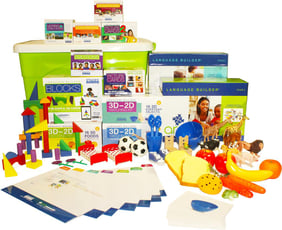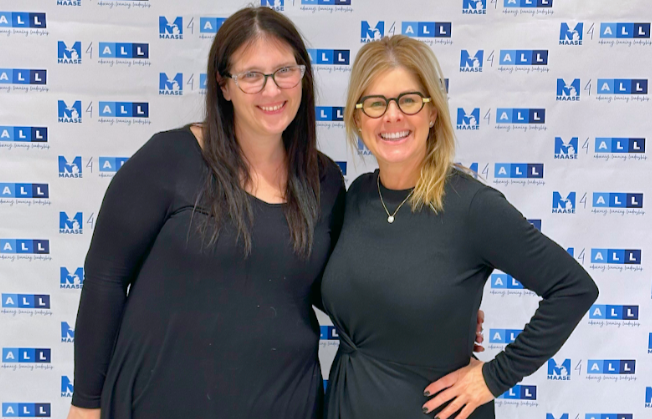Best Games, Stories, Rhymes and Songs to Support Early Math Skills for Autistic Students
This resource was created as a supplement for the ARIS® Academic Readiness Intervention System (ARIS) complete early autism curriculum, Lesson #168, Recited Counting 1-10, Lesson #173, Receptive Numbers 1-10, Lesson #174, Expressive Numbers 1-10, Lesson #175, Receptive Numbers 11+ and Lesson #176, Expressive Numbers 11+. Download a free copy of lesson 168, lesson 173, lesson 174, lesson 175, and lesson 176, and learn more about the ARIS curriculum.
Developing early math skills is crucial for a child’s later success. Games, stories, rhymes, and songs provide engaging ways to teach children early math skills. For autistic children, the following games, stories, rhymes, and songs can also provide opportunities for developing social and emotional skills by using these resources in small group situations or one-on-one therapy or teaching settings.
Research suggests that a child who displays adequate early math skills tends to do better as they matriculate to higher grades, and eventually to the labor market 1. This same research suggests that out of literacy, math skills, and attention skills, early math readiness has the greatest predictive power of a child’s later educational success 1. In addition, adequate development of early math skills can support a child’s critical thinking and reasoning abilities 2.
Thus, it is extremely important that students develop a sense of math readiness at an early age. While math can be challenging for many students, it may present unique challenges to autistic students. Some autistic students may find math calculation relatively easy, while other students may find math application problems much more challenging. Regardless of a student’s academic abilities, engaging in math skills early on can support students’ academic development, and grow their confidence in math.
ARIS Connection and Early Math Skills
As the most complete autism education curriculum available, ARIS is founded on the principles of Applied Behavior Analysis (ABA) therapy and utilizes the Language Builder Picture Card sets to effectively support holistic student learning. Coupled with the Language Builder Picture Cards, ARIS includes 202 detailed lessons for teachers and parents to use to effectively support their child’s language development, functional routines, approaches to learning, reading and writing, mathematics, social-emotional, and motor skills.
The Math Readiness content category explicitly focuses on supporting an autistic student’s early math skills and includes six subcategories:
- Patterns
- Numbers and Counting
- Operations
- Geometry
- Measurement and Data
- Time and Money
All of these categories follow a standards-based learning progression and specifically relate to the Common Core State Standards. The lessons in the Math Readiness content category are created to provide a foundational understanding of early math skills to effectively prepare students for critical life skills such as measuring, comparison, time, and money.
Below is a carefully selected collection of games, stories, rhymes, and songs that can not only make math more engaging but also aid in effectively teaching a child early math skills. These resources can be used to supplement ARIS lessons to provide additional support for math readiness.
Games That Support Early Math Skills
Educational math games are great resources to use in the classroom to help develop a child’s math skills. For autistic students, games can be a great way to support their engagement and attention, while also learning key social skills. The games below are examples pulled from the ARIS lessons on Math Readiness.
Pattern Card Game
This game supports autistic students in understanding patterns. To play, you will need to create a deck of cards using construction or patterned wrapping paper.
 Using blank, white index cards as a template, trace 10 to 15 of each color or pattern. The number of colors or patterns that are included in the card deck depends on the student’s mastery of the skill.
Using blank, white index cards as a template, trace 10 to 15 of each color or pattern. The number of colors or patterns that are included in the card deck depends on the student’s mastery of the skill. - Create the cards by gluing or laminating together one white index card and one colored or patterned piece of paper to form cards that are blank on one side.
- Take all of the cards, blank side up, and shuffle them to form a deck. Draw 3 or 4 cards to establish the pattern. Then, each player should take 5 cards. The remaining cards are stacked in the center.
- Take turns placing the next card in the pattern from your hand. If none of your cards fit the pattern, draw from the remaining cards until you have the right card. Continue until someone runs out of cards or until all of the center cards have been drawn!
Number Line Jam
This game allows autistic students to work on their number and counting skills. To play, you will need to create a number line from 1 to 10 on the floor using masking tape. Begin by playing music and dancing with the student, and then pause the music and hold up a target number flash card. The student will then have to walk, hop, jump, skip, or crawl to the number and say the number name out loud. This can be repeated until you have reviewed all numbers from 1 to 10 with the student.
Chain Addition
This game allows autistic students to explore operations, specifically addition. To play, you will only need a standard deck of cards.
- Begin by separating all of the numbers that the student is comfortable adding, and then set those cards aside as Deck 1.
- For the remaining cards, make sure to only include the cards the student can add. This will be considered as Deck 2. At first, you can remove the jacks, queens, and kings, but once the game rules are familiar, feel free to make up what jacks, queens, and kings represent (i.e. each jack equals a reward).
- Once your decks are separated, begin playing by asking the student to pull a card from Deck 2 and then Deck 1. Then, ask the student to add the numbers together. If they get it correct, they can keep the card. If not, the card goes back into the deck. Continue this game until all of the cards have been pulled.
Shape Attribute Hunt
This game allows autistic students to work on identifying attributes for various shapes. To play, begin by giving the student a specific attribute to look for, such as something with four sides. Then, walk around the classroom, school, or physical area with the student as they search. Once the student finds the object, you can spend time naming the shape and its attributes. To mix it up, switch roles with the student!
Clock Walk
This game allows autistic students to practice their math readiness skills as it relates to telling time.
- First, tape one set of digital time flashcards onto the wall.
- Then, scatter a matching set face-up on the floor, with enough space between each card for the student to walk around.
- Next, play kid-friendly music and ask the student to walk around the room. Pause the music, and then ask the student to find the nearest card on the floor. Then, instruct them to match the card on the floor to the one taped on the wall. Continue playing until all of the cards have been matched.
Stories that Support Early Math Skills
Math stories are another great resource to use for autistic students. In addition to supporting students’ math readiness, picture books can also support vocabulary development, story analysis skills, and sentence structure skills. The math stories below are great resources to support an autistic child's early math skills by not only deepening their understanding of different math concepts but also supporting their curiosity and increasing a positive perception towards math.
 The Waterhole by Graeme Base
The Waterhole by Graeme Base
The Waterhole by Graeme Base is not only a beautifully illustrated book, but it supports students’ skills in numbers and counting. This book also serves as a great example of the relationship between cause and effect: as more and more animals come to the waterhole to drink, the amount of water in the waterhole decreases.
 Feast for 10 by Cathryn Falwell
Feast for 10 by Cathryn Falwell
Feast for 10 by Cathryn Falwell is another counting book that details a family’s experience as they shop at the grocery store and prepare for a family meal. This book contains great pictures and easy-to-read text that utilizes rhymes and rhythmic patterns.
 Inch by Inch by Leo Lionni
Inch by Inch by Leo Lionni
Inch by Inch is a book that supports a student’s early math skills in the measurement and data subcategory. In this clever book, an inchworm expresses how it can measure all things. However, when asked to measure a song, the inchworm has to figure out how to respond. Students with autism will love this book and learn about a unit of measurement in the process!
 Mr. Noisy’s Book of Patterns by Rozanne Lanczak Williams, illustrated by Kathleen Dunne
Mr. Noisy’s Book of Patterns by Rozanne Lanczak Williams, illustrated by Kathleen Dunne
Mr. Noisy’s Book of Patterns is an engaging, fun, and whimsical book that allows students to learn more about patterns. While the text is written using patterns, the illustrations are also examples of patterns!
 The Greedy Triangle by Marilyn Burns, illustrated by Gordon Silveria
The Greedy Triangle by Marilyn Burns, illustrated by Gordon Silveria
The Greedy Triangle is a creatively written book about various polygons. Not only will it allow autistic students to better understand the differences between shapes, but it will also help students recognize shapes in real-life objects.
2 Comparisons Books
 Now What? A Math Tale (Robie H. Harris)
Now What? A Math Tale (Robie H. Harris)
This book is about Puppy, who wants to build a bed out of blocks. This book is a wonderful introduction to comparing shapes, sizes, and lines. Puppy uses his blocks to explore how shapes can be the same, different, and work together.
 Big and Small (Britta Teckentrup)
Big and Small (Britta Teckentrup)
This is a book of beautifully illustrated comparisons in nature. This book uses related items, fruits, and animals in nature to compare their sizes. This book serves as great practice for your child to receptively and expressively make comparisons, exploring same/different, small/big, short/long, and more.
2 Skip Counting Books
 The Skip Count Song (Rozanne Lanczak Williams)
The Skip Count Song (Rozanne Lanczak Williams)
This is a repetitive, predictable story to introduce skip counting. Count by two’s, five’s, and ten’s and explore number patterns through this high-contrast illustrated book. This book rhymes, so it is easily set to music and stays with kids.
 Count on Pablo (Barbara deRubertis)
Count on Pablo (Barbara deRubertis)
This book follows Pablo as he helps his grandmother sell vegetables at the farmer’s market. Pablo counts the produce by twos, fives, and tens and learns simple tricks for counting large amounts. This heartwarming story is a perfect way to introduce skip counting to your child.
Rhymes that Support Early Math Skills
All of us can name a nursery rhyme or two, no matter how long it has been since we heard it! Rhymes that focus on math concepts and skills are wonderful for autistic students. They can be an engaging and fun way for your child to remember key math concepts and skills. Try out some of the rhymes below to use when supporting your child with their math readiness.
Shape Rhymes (from www.teachingmama.org)
Circle, circle nice and round
Curve to the left till you come back around
Find the circles, just look and see!
Moon, sun, clock, and a yummy cookie!
A 3-sided triangle is easy to make!
Slide down, across, and up
And you’ve made the shape!
Find the triangles, just look and see!
A pizza slice, a flag, and a sailboat on the sea.
A rectangle has 4 sides, but they are not the same
Two sides are long
Two sides are short
Together they make a frame!
Find the rectangles, just look and see!
A computer screen, a door, and a dollar that’s for me!

Rhymes for Numbers and Counting
“1, 2 – Buckle my Shoe”
1, 2 – buckle my shoe.
3, 4 – knock at the door.
5, 6 – pick up sticks.
7, 8 – lay them straight.
9, 10 – a big fat hen.
For support with writing numbers (see all from Ms. White’s Wild Things)
Number 1 is like a stick,
A straight line down that’s very quick!
Around and around,
Just like a bee,
That’s the way to make a 3
Make an L, but wait
There’s more, add a
Stickman to make a 4
Telling Time Poem by Fit to Be Firsties
I’m the tortoise hour hand,
Short and stout.
I tell the hour and I give a shout.
I’m the hare minute hand,
Big and tall.
I tell the minute and that’s all.
We Can Measure! by Samantha Kelly
*This rhyme can be sung to the tune of “Jingle Bells”)
12 inches in a foot,
3 feet in a yard,
Using different units
Doesn’t have to be too hard!
100 centimeters
In a meter stick, you know
We can measure anything
Anywhere we go!
Songs That Support Early Math Skills
Similar to rhymes, songs can be a great resource to support math readiness. Not only are songs engaging, but they can also be a great resource upon which students can develop social skills. Check out some of the songs below from www.songsforteaching.com to use as you support students’ early math skills!
“Finish the Pattern” by Music with Mar.
Finish the pattern; patterns repeat
It’s something we can do that’s really neat
Listen to the pattern; figure it out
When we get to the missing word, say it with a shout
A B C, A B C, A B ____
2, 4, 6, 8, 2, 4,6, ____
Red, Blue, Red, Blue, Red, _____
Finish the pattern; patterns repeat
It’s something I can do that’s really neat
Let’s try using them another way
We’ll sing some patterns; what do you say?
La la li, la la li, la la ____
Loo Loo, la la; Loo Loo, la ____
Do Dah Dah Dee, Do Dah Dah Dee, Do Dah Dah ____
Many things are patterns; That’s very clear
The same 12 months; the same order each year
The hours go from 1 to 12; Then repeat we know
The days of the week over and over they go
Finish the pattern, patterns repeat
It’s something we can do that’s really neat
Free Audio Link: Finish the Pattern
“Chicken Count” by Jack Hartmann
1, 2, 3, 4, 5, 6, 7, 8, 9, 10
1, 2, 3, 4, 5, 6, 7, 8, 9, 10
Chickens out of the chicken pen!
Chicken 1 and Chicken 2
Chicken 1 and Chicken 2
Let’s all do the chicken chew
Let’s all do the chicken chew
(Make chicken sounds)
(Kids repeat the chicken sounds)
Chicken 2 and Chicken 3…
Chicken 3 and Chicken 4…
…Chicken 9 and Chicken 10
Let’s all struct back to our pen
1, 2, 3, 4, 5, 6, 7, 8, 9, 10
1, 2, 3, 4, 5, 6, 7, 8, 9, 10
Chickens back to the chicken pen!
Free Audio Link: Chicken Count
“Fact Family” by Music with Mar.
A fact family is when you use three numbers
To put together or take away.
No matter if you add or subtract, the same three numbers stay.
In a fact family!
1 + 2 is 3 and 2 + 1 is 3. 3 – 1 is 2 and 3 - 2 is 1.
That’s fun! Here’s another.
3 + 1 is 4 and 1 + 3 is 4. 4 – 3 is 1 and 4 – 1 is 3. In a fact family,
When you add numbers together, the answer is the same
Doesn’t matter which is first,
A turn-around fact is its name, in a fact family.
3 + 2 is 5 and 2 + 3 is 5. 4 + 2 is 6. 2 + 4 is 6. We’ll do some more.
8 + 1 is 9. 1 + 8 is 9. 6 + 4 is 10 and 4 + 6 is 10. In a fact family,
When you take the numbers in the family, to add or subtract
5 + 3 is 8; 8 - 5 is 3. Now that’s a related fact, in a fact family.
5 + 1 is 6 and 6 - 1 is 5. 6 + 2 is 8 and 8 - 2 is 6. Some more related facts.
9 + 1 is 10 and 10 – 9 is 1. 3 + 6 is 9 and 9 - 6 is 3.
In a fact family when you use three numbers
To put together or take away.
No matter if you add or subtract, the same three numbers stay.
In a fact family! It’s all relative!
“We Know Our Shapes” by Music with Mar.
We know our shapes so here’s what we’ll do
We’ll draw our shapes and sing them, too
A circle has one line.
One line that’s round
Start at the top
and make this sound
Whoop! (Whoop)
One round line
Whoop!
A square has four sides
that are all the same
Say this sound 4 times
to play this game
Wo Wo Wo Wo
Wo Wo Wo Wo
4 same sides on a square
A rectangle has 4 sides like a square
Two are short, two are long.
Draw them in the air
Wo WHEW Wo WHEW
Wo WHEW Wo WHEW
2 long, 2 short
rectangle
Wo whew, wo whew
A triangle is different;
Its sides are three
Draw 3 sides
and make this sound with me.
Ting, Ting, Ting
Ting, Ting, Ting
The triangle has 3 sides
Ting, Ting, Ting
We know our shapes.
Yes, we do.
We can draw them and sing, them, too!
Free Audio Link: We Know Our Shapes
“The Measurement Song” by Music with Mar.
There are different ways to measure
How much or how long
Let's sing about measurement
In a measurement song
If we want to know how much,
We can start with an ounce
Then would be a cup
Next comes a pint, then a quart
Then a gallon. It all adds up.
For how long, we start with millimeters
Centimeters, then an inch
Next is a foot then a yard
You can measure. It’s a cinch!
Free Audio Link: The Measurement Song
“Money 1 cent, 5 cents, 10 cents” by Ron Brown
I have a penny in my pocket.
That’s one cent.
Copper brown, it’s worth 1 cent.
A penny in my pocket, it’s worth one.
Counting money is so much fun.
I have a nickel in my pocket.
That’s five cents.
Silver and round, it’s worth 5 cents.
A nickel in my pocket, it’s worth five.
Counting money is fun to try.
I have a dime in my pocket.
That’s ten cents.
Silver and small, it’s worth 10 cents.
A dime in my pocket, it’s worth ten.
Let’s count our money once again.
Free Audio Link: Money 1 cent, 5 cents, 10 cents
References
1. Duncan, G. J., Dowsett, C. J., Claessens, A., Magnuson, K., Huston, A. C., Klebanov, P., Pagani,S., Feinstein, L., Engel, M., Brooks-Gunn, J., Sexton, H., Duckworth, K., & Japel, C. (2007). School readiness and later achievement. Developmental Psychology, 43(6), 1428–1446. https://doi.org/10.1037/0012-1649.43.6.1428
2. Good2Know Network. (2019, May 30). Why is Math Important in Early Learning? [Web log post]. Retrieved December 11, 2020, from https://www.good2knownetwork.org/g2k-info-hub/why-is-math-important-in-early-learning
This resource was created as a supplement for the ARIS Language Builder complete early autism curriculum, Lesson #168, Recited Counting 1-10, Lesson #173, Receptive Numbers 1-10, Lesson #174, Expressive Numbers 1-10, Lesson #175, Receptive Numbers 11+ and Lesson #176, Expressive Numbers 11+. Download a free copy of lesson 168, lesson 173, lesson 174, lesson 175, and lesson 176, and learn more about the ARIS curriculum.

Madeline Burroughs
Madeline Burroughs is a Specially Designed Instructional Coach at two high schools in Fulton County Schools in Atlanta, GA. In this role, she works to coach special education teachers in providing systematic, specially designed instruction that effectively targets students’ strengths and needs. Madeline received her Master’s degree in Education Policy and Management from Harvard Graduate School of Education in May 2019, and hopes to continue to serve as an advocate for all students with disabilities throughout her career.






